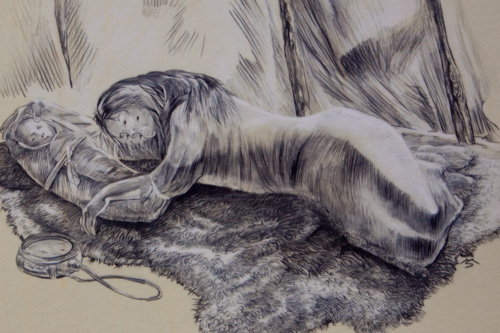Below the Great Falls of the Missouri, Sacagawea‘s health deteriorates, and Charbonneau asks her to return home. Towing the boats becomes increasingly difficult. Several miles ahead, Lewis fishes and describes a prairie rattlesnake in minute detail. Back in St. Louis, Pierre Chouteau ships Lewis’s Fort Mandan specimens, and the barge arrives at Fort Massac.
Clark Arrives at the Falls
by Yellowstone Public Radio[1]Originally aired weekdays by Yellowstone Public Radio during the Bicentennial observance of 2003-2006. Narrated by Hal Hansen. Scripts by Whit Hansen and Ed Jacobson. Produced by Leni Holliman. © … Continue reading
Sacagawea and Jean Baptiste
From an interpretive sign at Sulpher Spring photographed 2013 by Kristopher K. Townsend.
Sacagawea Much Worse
our Indian woman [Sacagawea] Sick & low Spirited I gave her the bark & apply it exteranaly to her region which revived her much.
the Indian woman much wors this evening, She will not take any medison, her husband [Toussaint Charbonneau] petetions to return &c.,
—William Clark
Hauling the Cord
the men in the water from morning untill night hauling the Cord & boats walking on Sharp rocks and round Sliperery Stones which alternately cut their feet & throw them down, not with Standing all this dificuelty they go with great chearfulness, aded to those dificuelties the rattle Snakes inumerable & require great caution to prevent being bitten.
—William Clark
Counting Rattlesnake Scuta
I killed the snake and found that he had 176 scuta on the abdomen and 17 half formed scuta on the tale; it was of the same kinde which I had frequently seen before; they do not differ in their colours from the rattle snake common to the middle attlantic states, but considerably in the form and figures of those colours.
—Meriwether Lewis
Amusing Fish
I amused myself in fishing, and sleeping away the fortiegues of yesterday. I caught a number of very fine trout which I made Goodrich dry; goodrich also caught about two douzen and several small cat of a yellow colour which would weigh about 4 lbs.
—Meriwether Lewis
Weather Diary
State of the thermometer at rise
Weather Wind at rise
State of the thermometer at 4 OC. P.M. Weather Wind at 4 OC. P. M. State of river 60 [above 0] fair S. W. 76 [above 0] fair S W fallen ½ in. The deer now begin to bring forth their young the young Magpies begin to fly. The Brown or grizzly bear begin to coppolate.
—William Clark[2]To assist the reader, the editor of this web page has omitted the date column, merged the “State of the river” columns, and spelled out some abbreviations.
Shipping Lewis’s Specimens
Pierre Chouteau arranges the shipment of Lewis’s Fort Mandan specimens from St. Louis to Washington City via New Orleans.
St. Louis 15 Juin 1805
Mr [William Claiborne]
Capn. Lewis having sent by his barge from the Missoury river two trunks, two cages or boxes with some birds and one [Ditto] with a prairy Dog [Prairie Dog], which are to be send according to his instructions, to the President of the United States, I send them to you by Mr. Mallock according to his receipt here annexed, as the only proper opportunity to take them with safety to Washington city. I beg you will give me notice of theyr safe arrival at new Orleans. I am Sir very respectfully, &c. &c.
[Pierre Chouteau][3]Letters of the Lewis and Clark Expedition with Related Documents: 1783–1854, 2nd ed., ed. Donald Jackson (Urbana: University of Illinois Press, 1978), 248–49.
The Barge at Fort Massac
Two expedition members arrive at Fort Massac with the expedition’s barge sent back from Fort Mandan.
Massac June 15th 05
Sir [Henry Dearborn]
Two men who accompanied Capt. Lewis on his tour, were of the party which brought me Major Bruffs letter, & from them I have collected the information you will find under cover, which I transmit, as I know not whether Capt Lewis’s dispatches have been forwarded.—
Ja: Wilkinson[4]James Wilkinson to Henry Dearborn in Clarence E. Carter, The Territorial Papers of the United States (Washington, DC: United States Government Printing Office, 1948), 13:135–36, digitized by Google … Continue reading
Notes
| ↑1 | Originally aired weekdays by Yellowstone Public Radio during the Bicentennial observance of 2003-2006. Narrated by Hal Hansen. Scripts by Whit Hansen and Ed Jacobson. Produced by Leni Holliman. © 2003 by Yellowstone Public Radio. |
|---|---|
| ↑2 | To assist the reader, the editor of this web page has omitted the date column, merged the “State of the river” columns, and spelled out some abbreviations. |
| ↑3 | Letters of the Lewis and Clark Expedition with Related Documents: 1783–1854, 2nd ed., ed. Donald Jackson (Urbana: University of Illinois Press, 1978), 248–49. |
| ↑4 | James Wilkinson to Henry Dearborn in Clarence E. Carter, The Territorial Papers of the United States (Washington, DC: United States Government Printing Office, 1948), 13:135–36, digitized by Google books. |

